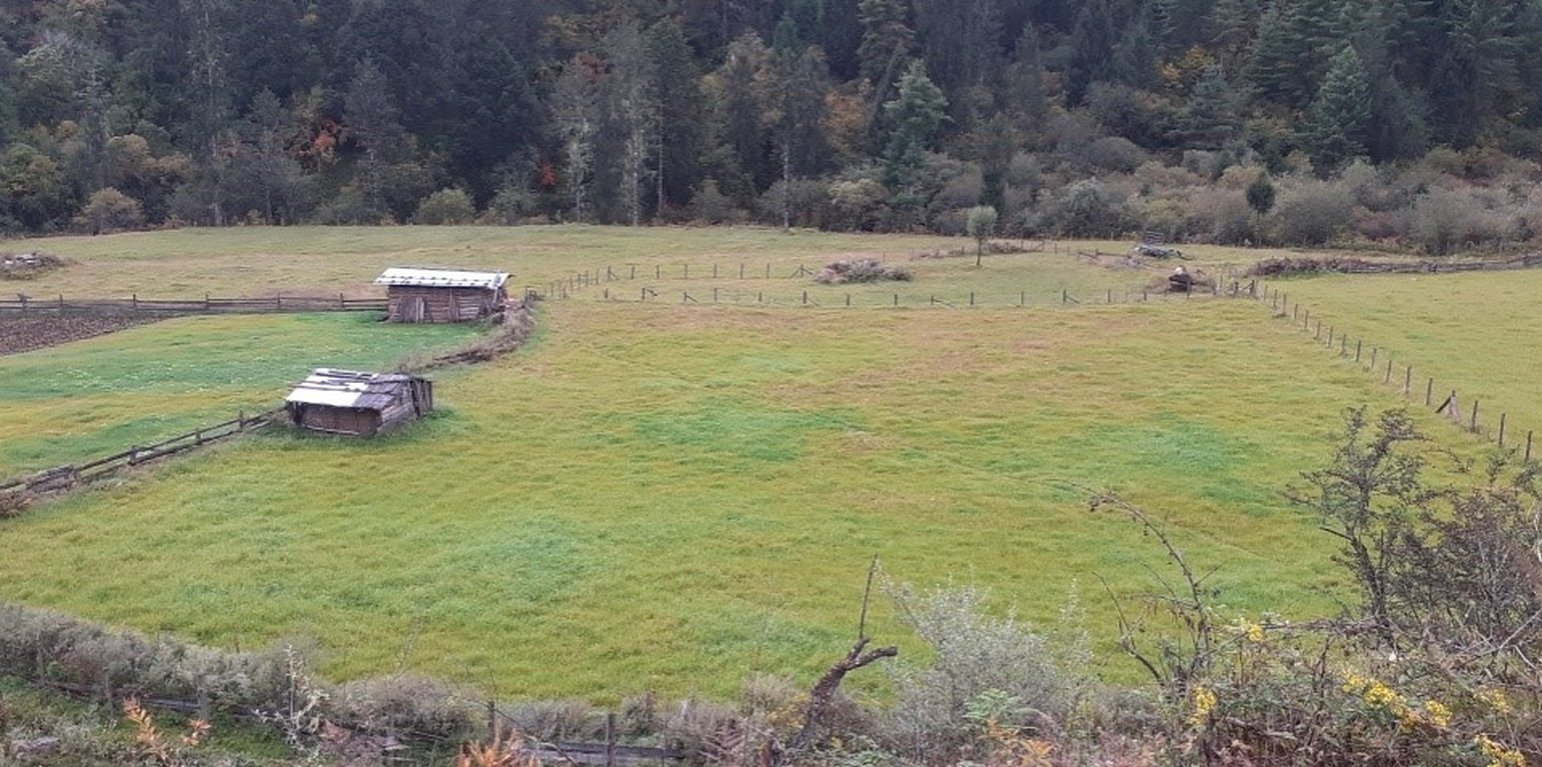Improved Pasture Development
(Bhoutan)
Tsamdro Yardrak Tangthang (ཙྭ་འབྲོག་ཡར་དྲག་བཏང་ཐངས་།)
Description
The improved pasture development approach focuses on enhancing pasture productivity, which is managed sustainably for grazing. Livestock productivity depends greatly on improved pastures. It is very important to manage pastures to support the livelihoods of rural communities in Bhutan.
The improved pasture development approach in Bhutan started at the beginning of the 5th Five Year Plan (1982-1987). Thangbi village, Bumthang, focuses on enhancing pastureland productivity and sustainability through the cultivation of improved varieties of grasses provided by the project. This initiative not only prevents land degradation and erosion but also enhances fertility by introducing leguminous species like clover. In temperate areas, improved pasture consists of a mixture of white clover, tall fescue, cocksfoot, and Italian ryegrass while in the subtropical areas, green leaf desmodium, molasses grass (Melinis sp.), ruzi grass (Brachiaria sp.), and stylo are grown.
Given the significant role livestock plays in the livelihood of Bhutanese communities, where productivity is strongly influenced by seasonal variations in fodder availability, improved pasture development addresses crucial objectives. These are: 1) Enhancing the resilience of pasture ecosystems to ensure continuous, high-quality fodder production; 2) Increasing forage availability and quality by promoting the cultivation of improved fodder species; and 3) Improving livestock productivity, directly impacting income generation through increased yields of animal products - especially of milk, cheese, and butter.
Implementation involves four stages: 1) Initial assessments of pasture conditions and land suitability, conducted by livestock extension officials; 2) Planning sessions involving officials from the Department of Livestock and land users; 3) Establishment of the identified areas for growing improved fodder species; and 4) Management of improved pasture plots by land users, accompanied by regular monitoring and evaluation to ensure effectiveness.
Key stakeholders in this approach include livestock extension agents and community members. Livestock extension agents act as a liaison between the community and the government. They also procure and distribute fodder grass seeds. Community members establish pastures in their farms, taking on responsibilities such as monitoring the water supply and caring for the grasses throughout their growing seasons.
Land users appreciate the approach because it ensures abundant fodder availability year-round, improving milk production through the cultivation of superior grass species, and reducing the workload associated with foraging in forests or tending grazing cows. However, concerns raised by land users include a reduction in cultivable land due to fodder grass cultivation and a lack of training regarding fodder management for those involved in the approach.
Lieu
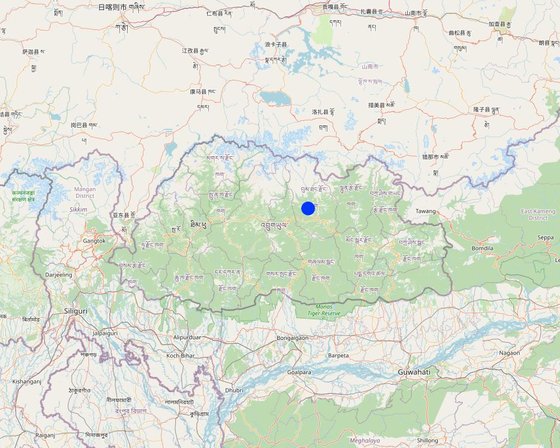
Lieu: Thangbi Village, Choekhor Gewog (Block), Bumthang Dzongkhag (District), Bhoutan
Géo-référence des sites sélectionnés
Date de démarrage: 1980
Année de fin de l'Approche: sans objet
Type d'Approche
-
traditionnel/ autochtone
-
initiative/ innovation récente locale
-
fondé sur un projet/ programme
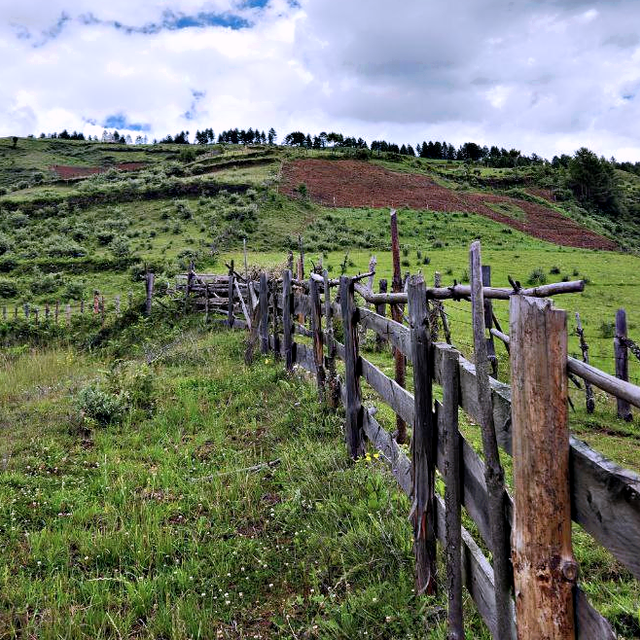
Pasture land established in Thangbi village (Tshewang Phuntsho)
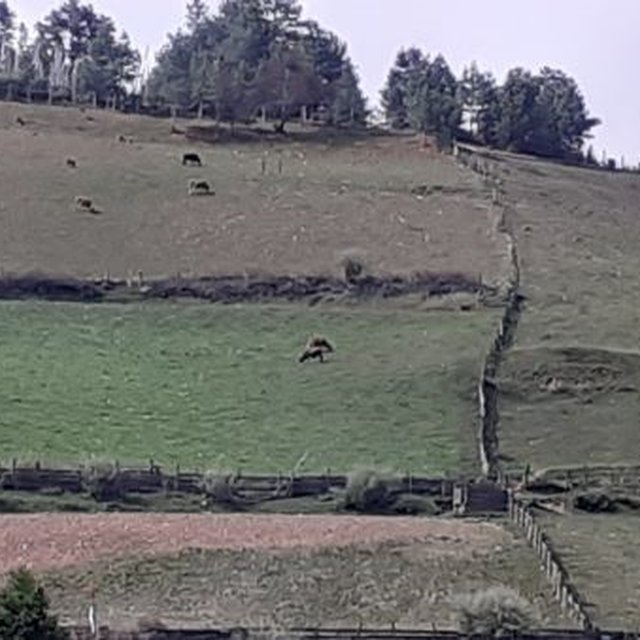
Improved Pasture land (Wangchuk, National Centre for Animal Health, Bumthang)
Objectifs de l'approche et environnement favorable
Principaux objectifs de l'Approche
1) Enhance the resilience of pasture ecosystems: For countries like Bhutan, fodder production is largely affected by season and during off season, the productivity goes down drastically, leaving many land users in distress. Therefore, improved pasture development enables land users to continuously harvest quality fodder for their cows.
2) Increase forage availability and quality: The improved pasture development approach not only focuses on the production of fodder in quantity but also the quality by encouraging land users to grow improved varieties of fodder species.
3) Improve livestock productivity: Improving productivity is the primary objective as it directly connects to the quantity of animal produce like milk, cheese, butter, etc., that affects the income generated.
Conditions favorisant la mise en oeuvre de la/(des) Technologie(s) appliquée(s) sous l'Approche
-
Normes et valeurs sociales/ culturelles/ religieuses : Community members/land users shared the same social, cultural, and religious norms and values. Implementation of any project didn't have any issues.
-
Disponibilité/ accès aux ressources et services financiers: Community members/land users are provided with improved varieties of fodder grass for free based on the area of the land.
-
Cadre institutionnel: The improved pasture development has helped improve the livelihood of the community members.
-
Charge de travail, disponibilité de la main-d'œuvre: The workload has relatively decreased: In the past, community members had to go to the forest to either collect fodder or look after cow that graze on the grasses, but now pasture grass is readily available.
Conditions entravant la mise en oeuvre de la/(des) Technologie(s) appliquée(s) sous l'Approche
-
Connaissances sur la GDT, accès aux supports techniques: The land users know that pasture development is directly related to SLM, however land users didn't receive any trainings on the improved pasture development through the approach.
Participation et rôles des parties prenantes impliquées dans l'Approche
Parties prenantes impliquées dans l'Approche et rôles
| Quels acteurs/ organismes d'exécution ont été impliqués dans l'Approche? |
Spécifiez les parties prenantes |
Décrivez le rôle des parties prenantes |
| exploitants locaux des terres / communautés locales |
Community members |
Receive the fodder grass seeds and establish pasture lands in their registered lands. He/she also monitors the water requirement and takes care of the grasses throughout its growing seasons. |
| Department of Livestock, Ministry of Agriculture and Livestock |
Livestock extension agent |
The livestock extension agent act as a bridge between the community and the governments. He/she handles the project at the grassroots level by meeting and discussing improved pasture development personally with the interested land users. He/she is responsible for procuring the seeds of fodder grasses and distributing them to the community members. |
Participation des exploitants locaux des terres/ communautés locales aux différentes phases de l'Approche
aucun
passive
soutien extérieur
interactive
auto-mobilisation
initiation/ motivation
Livestock extension agent upon consultation with research centers will carry out initial assessments of pasture conditions (which species of pasture grass species to be grown) and land suitability study.
planification
The livestock extension agent and the community members decided on how to establish and implement the project.
mise en œuvre
In the initiation phase grass species are already identified and once planning is done. Land users will be provided seeds and they have to establish the pasture on their own.
suivi/ évaluation
Monitoring of pasture field is normally done by the community members, and ocasionally it is monitored by the extension for scheduled reporting purpose.
Diagramme/ organigramme
The flow chart was created based on the information provided by the community members.
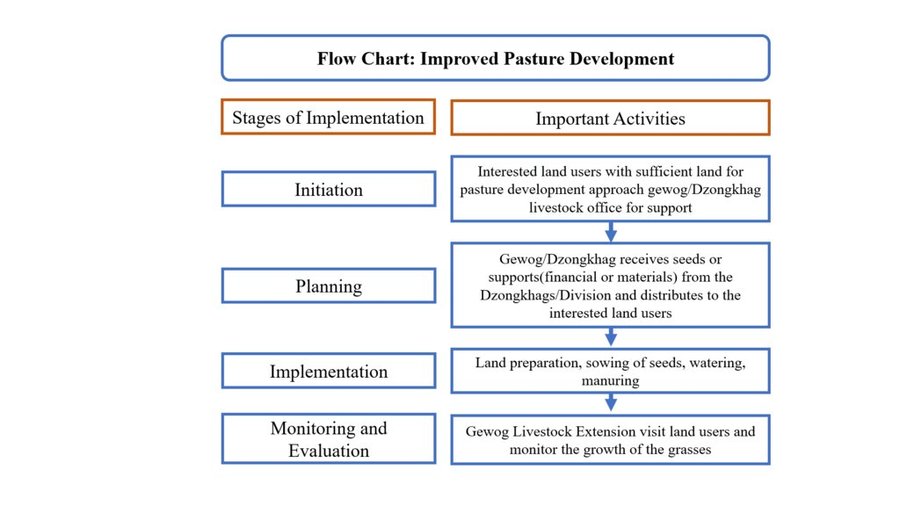
Auteur : Ongpo Lepcha
Prises de décision pour la sélection de la Technologie de GDT
Les décisions ont été prises par
-
les exploitants des terres seuls (auto-initiative)
-
principalement les exploitants des terres soutenus par des spécialistes de la GDT
-
tous les acteurs concernés dans le cadre d'une approche participative
-
principalement les spécialistes de la GDT, après consultation des exploitants des terres
-
les spécialistes de la GDT seuls
-
les responsables politiques/ dirigeants
-
Livestock extension agent
Les décisions ont été prises sur la base de
-
l'évaluation de connaissances bien documentées en matière de GDT (prises de décision fondées sur des preuves tangibles)?
-
les résultats de recherches?
-
expériences et opinions personnelles (non documentées)
-
Consultation with research centers
Soutien technique, renforcement des capacités et gestion des connaissances
Les activités ou services suivants ont fait partie de l'approche
-
Renforcement des capacités/ formation
-
Service de conseils
-
Renforcement des institutions (développement organisationnel)
-
Suivi et évaluation
-
Recherche
Service de conseils
Le service de conseils était fourni
-
dans les champs des exploitants?
-
dans des centres permanents
Whenever community members require any sort of technical assistance or advisory services, Livestock Extension agent at their capacity provides the support. however, if higher intervention is required EA solicit supports from the dzongkhag, Central programs and the department of livestockand accordingly provide assistance.
Renforcement des institutions
Institutions ont été renforcées ou mises en place
-
non
-
oui, un peu
-
oui, modérément
-
oui, beaucoup
Décrivez l'institution, ses rôles et responsabilités, ses membres, etc.
The livelihood of the community has been relatively better with the improved pasture development.
Type de soutien
-
financier
-
renforcement des capacités/ formation
-
équipement
-
Planting materials
Plus de détails
The extension agent would provide improved pasture grass seeds based on the availability of budget for seeds procurement.
Suivi et évaluation
Monitoring is mostly done by the community members.
Financement et soutien matériel externe
Budget annuel en dollars US de la composante GDT
-
< 2 000
-
2 000-10 000
-
10 000-100 000
-
100 000-1 000 000
-
> 1 000 000
Precise annual budget: sans objet
The funding is mostly in terms of cost of the improved pasture grass varieties.
Les services ou mesures incitatives suivantes ont été fournis aux exploitants des terres
-
Soutiens financiers/ matériels fournis aux exploitants des terres
-
Subventions pour des intrants spécifiques
-
Crédits
-
Autres incitations ou instruments
Analyses d'impact et conclusions
Impacts de l'Approche
Non
Oui, un peu
Oui, modérément
Oui, beaucoup
Est-ce que l'Approche a aidé les exploitants des terres à mettre en œuvre et entretenir les Technologies de GDT?
No workshop or tainings were provided to the community members, however, they relied on their traditional knowledge on pasture land management.
Est-ce que l'Approche a amélioré les connaissances et les capacités des exploitants des terres pour mettre en œuvre la GDT?
Community members relied on their traditional knowledge about pasture grass management
Est-ce que l'Approche a construit/ renforcé les institutions, la collaboration entre parties prenantes?
The livelihood of the community has relatively improved compared to the past.
Est-ce que l'Approche a autonomisé les groupes socialement et économiquement défavorisés?
All the households in the community irrespective of their background were provided with the pasture grass seeds.
Est-ce que l'Approche a amélioré l'égalité entre hommes et femmes et autonomisé les femmes et les filles?
All genders were equally encouraged to participate
Est-ce que l'Approche a conduit à améliorer la sécurité alimentaire et/ou la nutrition?
The cultivated land has decreased due to the improved pasture land
Principale motivation des exploitants des terres pour mettre en oeuvre la GDT
-
augmenter la production
-
augmenter la rentabilité/ bénéfice, rapport coûts-bénéfices
-
réduire la dégradation des terres
-
réduire les risques de catastrophe
-
réduire la charge de travail
-
paiements/ subventions
-
règles et règlements (amendes)/ application
-
prestige, pression sociale/ cohésion sociale
-
affiliation à un mouvement/ projet/ groupe/ réseaux
-
conscience environnementale
-
coutumes et croyances, morale
-
améliorer les connaissances et compétences en GDT
-
améliorer l'esthétique
-
atténuer les conflits
Durabilité des activités de l'Approche
Les exploitants des terres peuvent-ils poursuivre ce qui a été mis en oeuvre par le biais de l'Approche (sans soutien extérieur) ?
Conclusions et enseignements tirés
Points forts: point de vue de l'exploitant des terres
-
Reduced workload
-
Fodder available in large amount
-
Higher milk production
Points forts: point de vue du compilateur ou d'une autre personne-ressource clé
-
Reduction of surface runoff
-
Increase fertility of the soil
Faiblesses/ inconvénients/ risques: point de vue de l'exploitant des terrescomment surmonter
-
Reduction in cultivated land
-
Land users have to depend on livestock officers for seeds
Training on seed production can be given to enhance their skills
Faiblesses/ inconvénients/ risques: point de vue du compilateur ou d'une autre personne-ressource clécomment surmonter
Références
Examinateur
-
William Critchley
-
Rima Mekdaschi Studer
-
Joana Eichenberger
Date de mise en oeuvre: 17 juillet 2023
Dernière mise à jour: 4 juin 2024
Personnes-ressources
-
Baleymo - exploitant des terres
-
Sonam Choden - exploitant des terres
-
Phurpa Wangmo - exploitant des terres
Description complète dans la base de données WOCAT
Données de GDT correspondantes
La documentation a été facilitée par
Institution
- National Soil Services Centre, Department of Agriculture, Ministry of Agriculture & Livestock (NSSC) - Bhoutan
Projet
- Strengthening national-level institutional and professional capacities of country Parties towards enhanced UNCCD monitoring and reporting – GEF 7 EA Umbrella II (GEF 7 UNCCD Enabling Activities_Umbrella II)
Références clés
-
Marzban, S. & Valizadeh, N. (2020). Pasture Development: Fundamentals and Managerial Perspectives.: https://www.researchgate.net/publication/339074876_Pasture_Development_Fundamentals_and_Managerial_Perspectives
Liens vers des informations pertinentes disponibles en ligne
